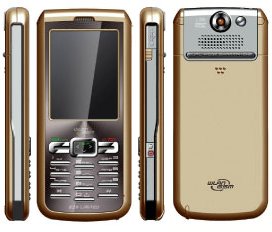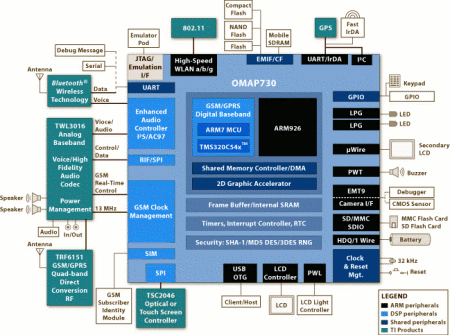Linux powers dual-mode multimedia smartphone
Mar 7, 2007 — by LinuxDevices Staff — from the LinuxDevices Archive — 3 views Taiwan-based phone designer and manufacturer Accton Technology Corp. is marketing a Linux- and Qtopia-based dual-mode phone design said to support both quad-band GSM and 802.11b/g networks. The VM3228T offers rich multimedia capabilities, and features seamless cellular/WiFi switch-over based on 3GPP standards,… according to the company.
Taiwan-based phone designer and manufacturer Accton Technology Corp. is marketing a Linux- and Qtopia-based dual-mode phone design said to support both quad-band GSM and 802.11b/g networks. The VM3228T offers rich multimedia capabilities, and features seamless cellular/WiFi switch-over based on 3GPP standards,… according to the company.

Mockup of Accton VM3228T
Accton says the VM3228T offers “rich multimedia and productivity” features,” including an Opera Internet browser, 15fps H.263 video playback at data rates up to 512 Kbps, and a 1.3-megapixel camera with photo editing and video recording capabilities.
The device is said to deliver a “seamless [dual-mode] communication experience,” thanks to support for the 3GPP's TR 23.806 release 7.0 specification for VCC (voice-call continuity) between circuit-switched (CS) networks and IMS (IP multimedia subsystem) networks. In other words, given carrier infrastructure support, the phone should be capable of toggling between cellular and WiFi networks in mid-call — for example, when the user enters or leaves a building.
Another Linux phone vendor, E28, has also demonstrated what it claims to be standards-compliant VCC support, in partnership with infrastructure equipment vendor Bridgeport Networks. E28's VCC-capable E2831 — which is available as a reference design to phone manufacturers and network operators — appears to be a “dead ringer” (no pun intended) for the Accton VM3228T.
Like E28's E2831, the Accton VM3228T is based on TI's OMAP 730 “single-chip” mobile phone processor, a “tri-core” design incorporating an ARM9 applications processor clocked at 200MHz, and a digital GSM/GPRS baseband processor comprised of an ARM7 controller and TMS320C54x DSP (digital signal processor).

TI's OMAP730 is a single-chip mobile phone chipset
(Click to enlarge)
Additional VM3228T specifications include:
- Hardware:
- 64MB NAND flash
- MicroSD slot supporting cards up to 2GB
- 64MB SDRAM
- 2.2-inch QVGA (240×320) TFT LCD touchscreen with 262K colors
- Bluetooth: 1.2, HSP Profile, OPP Profile
- USB 1.1 client, with connector used for data, charging. and earphone
- 1.3-megapixel CMOS camera
- Mono speaker in back for speakerphone use
- Candybar form factor
- 4.4 x 2 x 0.5 inches (112mm x 50mm x 12.5mm)
- 960mAH battery
- Software:
- “Linux operating system”
- Supports American English, simplified or traditional Chinese, with French, German, Italian, Portuguese, and Spanish optionally supported
- Handwriting recog with next word association, supporting simplified or traditional Chinese, “Hong Kong subset”
- SMS, MMS, and IM (OMA IMPS) clients
- PIM with calculator, world alarm clock, calendar, memo, addressbook, etc.
- MS Outlook contacts sync via USB cable
- Audio/video playback and recording supporting various codecs
- POP3/SMTP/eSMTP email client
- Opera HTML browser
- Esmertec WAP browser
- Java J2ME, MIDP 2.0, CLDC 1.1
Availability
No availability or pricing details have been supplied.
Accton previously delivered a dual-mode VM1188T phone design based on Linux and Qtopia.
Network stack and VoIP specialist HelloSoft offers VCC-enabled dual-mode network stacks for TI phone reference designs, including the OMAP850.
This article was originally published on LinuxDevices.com and has been donated to the open source community by QuinStreet Inc. Please visit LinuxToday.com for up-to-date news and articles about Linux and open source.